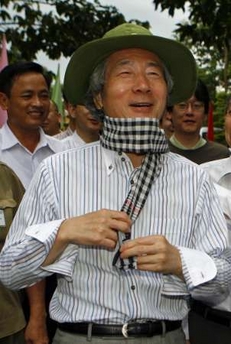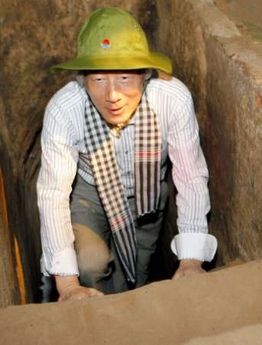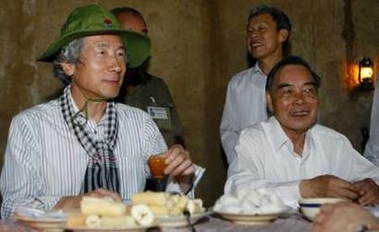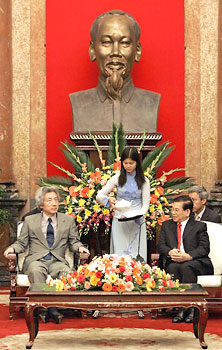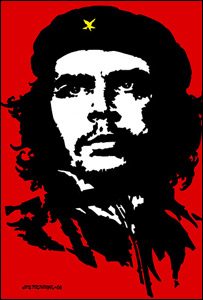Last week, awards were handed out for the “word of the year,” one of the biggest year-end wrap-up media events in Japan. The recent prizes have been split between the most trivial “ippatsuya” (one trick ponies) and Koizumi-related political drama. This year the top prize was shared between comedian/Miyazaki Prefecture Governor Sonomanma Higashi for his “something’s got to be done about Miyazaki”, and “prince of the cheese-eating grin” (usually translated as “bashful prince” but just look at him). Higashi’s questionably popular declaration indicates his ingenious plan to promote his prefecture by completely and utterly over-exposing himself in the media until his welcome wears out. The Prince, meanwhile, is a talented young golfer who was unwittingly dragged into intense media spotlight after winning a few tournaments. Here’s a quick listing of the runners up:
◆ Disappearing pension records (消えた)年金
◆ “That doesn’t matter” そんなの関係ねぇ a one-liner uttered by a half-naked one-trick-pony that’s not even funny the first time.
◆ Dondake- どんだけぇ~ (The beginning of a line intended to tease someone who’s over-enthusiastic)… see above, except it’s said by a cross-dresser and originated in Shinjuku-nichome gay slang.
◆”The power of insensitivity” 鈍感力 – the title of a best-selling book advising readers not to be “too sensitive”
◆ Fraudulent food (labeling) 食品偽装 Food companies got raked over the coals by regulators late this year for fudging on expiration dates that they knew were too short to begin with. This could also refer to the Made in China food scandals that (mostly) hit the US but were well-reported in Japan.
◆ Internet cafe refugees ネットカフェ難民 – the term for the semi-homeless who spend nights in Internet cafes
◆ Big eater 大食い – Not sure if this is in reference to the recently dethroned hot dog king Shigeru Kobayashi or those TV shows where the young woman eats plate after plate of sushi
◆ Very hot days 猛暑日 – after the hot summer
The list, arbitrarily selected by a committee from a list of reader submissions, seems to only have a memory going back around 6 months, and a highly selective one at that.
But though I understand that this award pays tribute to the spectacles that best gloss over the sadness, cruelty, and frustration of everyday life in this country, I must say the selections this year (save for the “disappearing pension records”) seem to almost willfully ignore the really big developments of this year, even in the realm of media events.
Even in terms of political sideshows, there was no mention of the stupendous problems in the government (Matsuoka’s suicide, the sudden and shocking resignation of Abe, the massive corruption in the Defense Ministry, for starters), nor even the Asashoryu or Kameda scandals despite reams of coverage and massive condemnation (and public interest) in both cases. Judging from the fragile state of all three institutions, one can understand why judges might have wanted to focus attention away from them and more toward fun or at least less testy topics.
In the same vein, the judges decided not to force the media-consuming audience to think back to January, when another vulnerable group was subjected to a major scandal. If we were to truly wrap up the year’s events, it would go without saying that the “Aru Aru Daijiten II” natto scandal would rank way higher than even “that doesn’t matter” in people’s memories… When people learned that the TV lied to them about the health benefits of natto (sticky beans), it may not have convinced them to drop all their food-related superstition-based health consciousness, but for a large group of people it marked a major loss of faith in the media.
Aru Aru, which was gratuitously dishonest and sloppy, may have been the most flagrant single example of media wrongdoing, but it was preceded and has been followed other incidents – more fakery, a misleading statement by morning show host Mino Monta during the Fujiya food scandal, and even reporters’ notoriously bad attitudes (caught on camera screaming at marathon fans, parking illegally, talking trash to commoners).
Though the editors of the Word of the Year decided that this fomenting animosity toward the media wasn’t worth mentioning, I expect such criticism of and animosity toward the news media to further intensify in 2008 (as the media will never fail to provide rage-inducing content). And as a reader of both, it will be increasingly harder to pick sides – what is worse, media institutions that lull the population into a stupor while passing off salivating coverage of the triple murder in Kagawa as a valid news story for a solid week, or the righteous masses of angry Internet users who will turn any slight offense into a target for attack?

